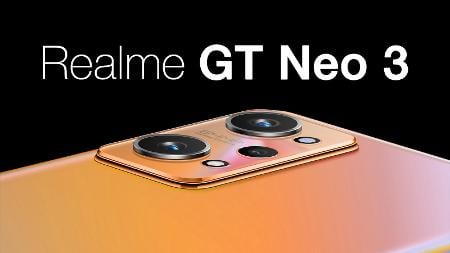[ad_1]
The focus of Realme’s MWC debut was undoubtedly its new GT 2 Pro flagships, however, the company did also tease the existence of the Realme GT Neo 3, which is set to feature class-leading 150W fast charging, when it launches later this year.
While the phone’s arrival is still a few months off, some of the fundamental details around the GT Neo 3 have already started to emerge. Based on rumours, official information and by looking at the Neo 3’s predecessors, we can build a picture of what to expect from this newest member of the Neo line.
When does the Realme GT Neo 3 go on sale?
While we don’t yet have a formal launch date for the phone, in a press Q&A session after the international launch of the GT 2 and 2 Pro at MWC, the company’s Madhav Sheth confirmed to Tech Advisor that the GT Neo 3 will be arriving later this year “in the first half of H2.”
This suggests a release window between July and September 2022, with last year’s GT Neo 2 first arriving in China in September 2021 and making its way to markets internationally by mid-November. The original GT Neo, meanwhile, never made it outside of China but launched in the region in late March 2021.
With this all in mind, it would seem the only logical overlap would be that we see the GT Neo 3 make its way to market sometime in September, but whether that manifests as a simultaneous launch or an initial China-only release is currently unclear.
How much is the Realme GT Neo 3?
Even with entries like the GT 2 Pro pushing the top end of Realme’s price range even higher, the company has always prioritised value for money as one of its products’ key selling points.
As such, while likely being the first phone (unless Oppo has something to say about it) on the market to boast 150W charging, even with the added cost that adding such technology might incur, we expect the GT Neo 3 to offer competitive pricing, just as its predecessors did.
The original GT Neo (packing a Dimensity 1200, 6GB RAM and 128GB storage) started at just CNY¥1,799 (approximately £210/€260/US$285/₹21,600/AU$390), while the base GT Neo 2 (with a Snapdragon 870, 8GB RAM and 128GB storage) cost ¥2,499 (approximately £295/€355/US$395/₹30,000/AU$540) in China and €449.99 in Europe.
With the ‘affordable flagship’ archetype that the existing GT Neo line’s pricing centres around, it stands to reason that the GT Neo 3 has the potential to hit the market from around ¥2,999/€550.
What features does the Realme GT Neo 3 offer?
Realme first officially acknowledged the GT Neo 3 at the European launch of the GT 2 series but didn’t even show imagery of the device, with only a single physical demo at their booth with developmental hardware showing off the phone’s forthcoming signature 150W ‘UltraDart’ charging.
#AchievementUnlocked How many seconds do you think was needed for us to go from 0% to 50%? #realme #UDCA #UltraDart pic.twitter.com/IpKwIg742n
— realme (@realmeglobal)
February 28, 2022
A day later, the company also confirmed that MediaTek’s newly-unveiled Dimensity 8100 chipset would reside at the heart of the Neo 3. While the Dimensity 9000 is MediaTek’s answer to the likes of the top-tier Snapdragon 8 Gen 1, the 8000 series (currently consisting of the Dimensity 8000 and 8100) operates on a fractionally larger 5nm die with an octa-core configuration comprised of four Cortex-A78 big cores and four Cortex-A55 small cores, accompanied by a Mali-G610 MC6, which relies of ARM’s latest GPU architecture.
Between the two, the Dimensity 8100 supports higher CPU and GPU frequencies, compared to the standard 8000, while the series as a whole also offers support for WiFi 6E and Bluetooth 5.3 standard (whether these are the specs we’ll see in the Neo 3 remains to be seen).
MediaTek suggested that the first phones running on 8000 series SoCs could arrive as soon as March 2022, however, such a launch window sits at odds with Realme’s own statements on the GT Neo 3’s release, implying phones from rival brands sporting these new Dimensitys will arrive ahead of the Neo 3.
Separately, the phone has already appeared on Chinese certification site TENAA, under the model numbers RMX3560 and RMX3562. Based on the listing, the Neo 3 will reportedly sport a 6.7in 120Hz Full HD+ AMOLED display with an in-display (presumably optical) fingerprint sensor, while that Dimensity chipset looks set to be supported by up to 12GB of RAM and 512GB of storage.
Imagery from both the TENAA entry and tipster OnLeaks (in collaboration with Zollege) reveal a new camera layout compared to anything we’ve seen from the company’s current portfolio, with what is reportedly an OIS-supported 50Mp primary sensor, along with supplementary 8Mp and 2Mp sensors, while on the front sits a 16Mp hole-punch front-facing camera.
As GT Neo 3 rumours and leaks already seem to be growing in frequency, the phone might be upon us sooner than we anticipate but until then, we’ll be keeping this feature up to date; so check back frequently.
[ad_2]
Source link




